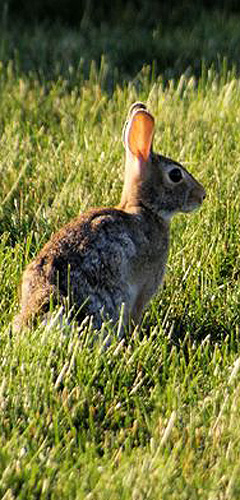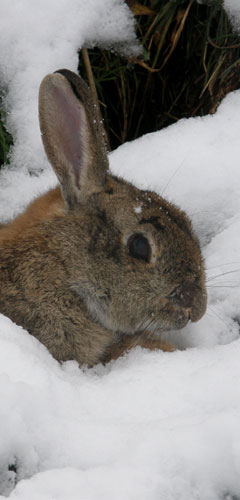- PEST PROBLEMS? CALL US NOW!
- 01865 362053 / 07802 485384
Pest Control for Rabbits
(Oryctolagus Cuniculus)
 Our rabbit control methods are effective and well managed. Our pest controllers have a wealth of knowledge and experience with all manner of rodents, and extensive skill and expertise when it comes to controlling rabbits.
Our rabbit control methods are effective and well managed. Our pest controllers have a wealth of knowledge and experience with all manner of rodents, and extensive skill and expertise when it comes to controlling rabbits.
The Hawthorn Pest Control team are able to offer a wide range of methods to control rabbits that are both effective and sustainable. We provide domestic control, as well as pest control for rabbits on agricultural and farm land to ensure that they are managed not only to prevent lawn damage, but also to protect crops and ensure burrows don’t cause injury to livestock. If controlling rabbits is a problem, our pest control team can work with you to implement an effective management programme.
Rabbits originated from the western Mediterranean, particularly Morocco and Spain. They were introduced into Britain during the twelfth century AD. Today, the most densely populated areas are in the south and south-east of England.
The key characteristics of the rabbit is long back legs, a flat body for fast running and long mobile ears. The rabbit can reach up to 45 cm in length and weigh between 1.3 – 2 kg. They are grey to brown in colour, with brown ear tips on their long ears.
Rabbits can be found in a wide diversity of habitats, including arable land, golf courses, moorland and sand dunes. If rabbits are present the most obvious indications are warren entrance holes. These are usually located at the bottom of hedgerows, bushes or other vegetation but may also be found in open ground. The warren entrance is usually 15 – 20 cm in diameter and, if it is in use, the soil in the hole will be smooth from the constant brushing of fur.
Tree saplings and fallen branches are often stripped as rabbits will eat tree bark. There may also be shallow scrapes in the soil where they have dug for edible roots. Larger scrapes can be seen where the rabbit has built a temporary ground nest.
Fresh droppings are normally an obvious indication of rabbits. Droppings can be left anywhere within their range and are often left on the edge of territories to act as scent marks. Rabbit droppings are dark brown and almost round, with a diameter of c. 10 mm. Rabbits pass around 360 droppings per day.
The footprints of rabbits are distinctive. They have hair on the underside of their feet to help grip at high speed and this hair softens the edges of the prints. The small forelegs have five toes and leave a tiny round print while the powerful hind legs leave a longer mark showing four toes. The hind feet leave a print measuring about 4 cm long and 2.5 cm wide. Well used rabbit runs between the warren and favourite feeding grounds can be found by looking for snags of fur caught on fence wire or low in hedges. Rabbits, like many species of mammals, can use roadside verges as feeding grounds.
All rabbit life and behaviour centres around the warren. There is a random series of underground tunnels, dens and bolt holes that provide safe refuge and dry breeding quarters. There can be as many as thirty rabbits in a single warren. Rabbits will forage up to 500 metres away from their warren, even further if vegetation is sparse.
Rabbits are normally nocturnal, emerging at dusk, although they will venture out during the day if they are not disturbed. Rabbits are highly adaptable in their use of habitats, although they do not like damp conditions or coniferous woodlands. They also avoid low land where the vegetation is dense. The ideal habitat consists of small arable or pasture fields surrounded by hedgerows. They are common in parks, on golf courses and railway embankment, and in gardens where they burrow under trees and sheds.
Rabbits have no vocal signs other than a piercing high-pitched scream in times of extreme stress. This is only usually used when a rabbit has been caught by a predator, as it acts as an ultimate danger signal. Apart from foot thumping, the rabbits’ main communication is through scent.
Rabbits are herbivores, feeding only on plant material. They eat a wide variety of plants, although their favourite foods include cereal crops, root vegetables, grasses and young shoots of most meadow plants. They will also nibble at the bark of young trees, as well as frequent and determined invaders of domestic gardens and allotments where vegetables are grown. Due to the low nutritional value of most plant material, rabbits need to take in large amounts daily and spend much of their waking time eating.
Rabbits reach maturity at around three and a half months old, and bucks at four months. The breeding season extends from January to August, although may vary considerably depending on local weather and food supply. Rabbits will mate throughout the year. The gestation period is between 28 – 31 days and an average litter consists of 5, although up to 12 is not uncommon. Females can produce up to 5 litters per year, leading to potential population explosions. In large populations, numbers can reach at least 100 per hectare.
Hawthorn Pest Control currently works with a number of clients to manage rabbit populations on an annual basis. The preferred method of control is through the use of ferrets and long nets, trapping and the use of trained dogs. However, our pest controllers will carry out a full site survey before proposing the best method of control and management.
For further details on the methods we use to control Rabbits, please visit our Traditional Methods of Pest Control page.


